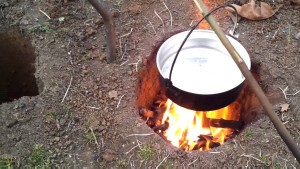 In a survival situation you are going to need to build a fire. You need to be able to do so quickly, with minimal resources available. Fire can provide warmth and is used for cooking. It is also great for repelling mother nature’s predators. The US Ranger Handbook and the US Army Survival Field Manual (FM 21-76) teach fire building skills, as it is considered to be such a life saving ability to master.
In a survival situation you are going to need to build a fire. You need to be able to do so quickly, with minimal resources available. Fire can provide warmth and is used for cooking. It is also great for repelling mother nature’s predators. The US Ranger Handbook and the US Army Survival Field Manual (FM 21-76) teach fire building skills, as it is considered to be such a life saving ability to master.
Unfortunately, your fire can also act as a homing signal for others, personal enemies, disaster survivors and other people intent on taking your possessions and possibly doing you harm.
Because of this, you will need to be able to build and hide a campfire if you ever find yourself in an emergency or disaster survival situation. Learn how to build a Dakota fire pit (also called a Dakota smokeless fire hole) and you’ll never have to worry about a campfire giving away your location. (The history of the Dakota fire pit is not agreed upon. Obviously it is attached in some way to the state of Dakota in the United States, but our research did not uncover solid agreement on its exact origins.)
What Is a Dakota Fire Pit?
The flames from your fire can be seen from more than a mile away over open terrain. (Even further at night.) So what if you hid those flames below ground? That is the basic idea behind the Dakota fire pit. The way it is created also produces minimal smoke, and the fire burns hotter because the heat is contained. Additionally, this “hidden” fire is very easy to start in a windy environment.
The size of your fire pit hole on the surface of the ground should be approximately 6 to 14 inches across. You can make the bottom of your pit larger, so you can add big pieces of firewood, and allow for better airflow. You want to dig down at least 20 or 24 inches if at all possible.
Dig a smaller hole which is upwind from your fire pit. This should be 8 to 12 inches from your fire hole. Dig at an angle, and connect to this airflow provider to the bottom of your fire pit. This allows the main section of your pit, directly over your fire, to serve as a chimney, and minimizes the creation of smoke.
Add kindling and light your fire. There are any number of fire starting devices, from a simple disposable Bic lighter to a metal survival fire starter. Once your kindling is going, add larger pieces of wood, branches and twigs. Maintain your fire as needed.
Whether you are using your fire for warmth, cooking your emergency food or to make safe drinking water, the Dakota fire pit can be customized to your needs. It delivers a very small light signature. Because of this it is endorsed by the United States Marine Corps. When not in use, simply cover your fire pit with camouflage which fits your local surroundings.
Comments are closed